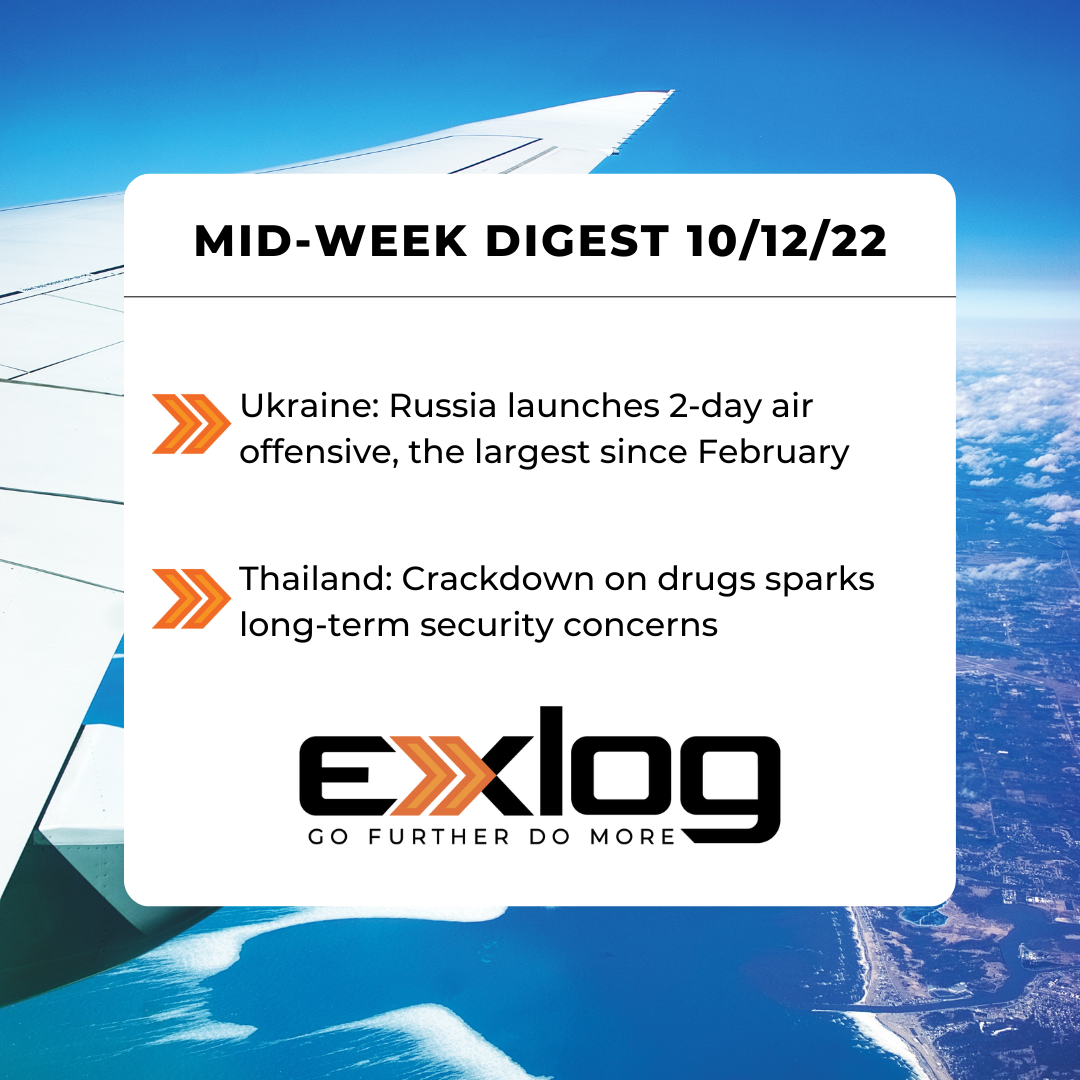Moscow Escalates Air Offensive in Ukraine and Thailand Renews Crackdown on Drugs
Ukraine: Russia Launches 2-Day Air Offensive, The Largest Since February
A wave of Russian airstrikes targeting civilian infrastructure shook 14 Ukrainian regions between Oct. 10-11, marking the largest escalation of the conflict since the initial invasion on Feb. 24. Ukrainian authorities estimate that Russia launched 84 cruise missiles and 24 kamikaze drones, though Ukraine’s air defense system managed to destroy 56 devices. In addition to the eastern areas of Ukraine – where the fighting has been concentrated in recent months – the missiles also struck Kyiv, Zhytomyr, Lviv, and other oblasts in central and western Ukraine, killing at least 26 people and injuring nearly 100 others. According to Ukrainian officials, the airstrikes damaged 70 infrastructure sites, including 29 critical facilities, triggering widespread power and communications outages across the country. Russian President Vladimir Putin stated that the recent air offensive was in retaliation for an Oct. 8 bomb attack on the Kerch Strait Bridge connecting the Crimean Peninsula with Russia. The incident caused significant damage to the bridge and temporarily halted road and rail traffic, disrupting a vital supply route for the Kremlin’s forces along Ukraine’s southern front. While Ukrainian officials have not claimed responsibility for the explosion, Moscow has accused Kyiv of terrorism and threatened further escalation in the event of additional attacks targeting “critically important civilian infrastructure.” The recent air raids also come amid reports of heavy Russian attrition in the Kherson, Donetsk, and Luhansk regions, after the Ukrainian army launched a major counteroffensive in September and regained control of dozens of population centers. Despite suffering these setbacks on the ground, the recent missile attacks have demonstrated Russia’s tactical capability to launch large-scale air offensives against both civilian and government targets; crucially, however, Moscow’s ability to sustain the air campaign remains unclear. As of Oct. 12, no significant attacks outside of the active combat zones in southern and eastern Ukraine have been reported, although future escalation in response to Ukraine’s ground offensive or the West’s rhetoric cannot be ruled out in the near-to-medium term.
Thailand: Crackdown on Drugs Sparks Long-Term Security Concerns
Thailand’s Prime Minister has ordered a crackdown on illegal drugs following a rare armed attack at a preschool in northeast Thailand on Oct. 6, increasing the likelihood of arbitrary violence and deterioration of the overall security environment across the country. A former police officer armed with a firearm and a knife stormed a preschool center located in the Na Klang district in Nong Bua Lamphu Province, killing 37 people and injuring at least two others. After fleeing the scene, the suspect returned to his home where he shot and killed his family and then himself. While the perpetrator was not reported to be under the influence of narcotics at the time of the incident, he was dismissed from the Royal Thai Police for methamphetamine possession and had earlier appeared in court on a drugs charge. In response to the incident, Prime Minister Prayuth Chan-ocha – whose party has been criticized by the opposition for ineffective anti-drug policies – instructed local authorities to increase searches and drug testing among public officials and residential communities and ordered the revocation of gun licenses from certain owners with a history of aggressive behavior. Previous Thai government declarations of a “war on drugs” have precipitated periods of increased state violence, including arbitrary killings and human rights abuses. For instance, the first three months of 2003’s anti-drug campaign recorded more than 2,800 extrajudicial killings, with only 48% of the victims having known connections to illegal narcotics. This precedent suggests that an overall deterioration of the security climate in Thailand is likely if police significantly intensify their crackdown against suspected drug users and other criminal actors engaged in drug trafficking. The Golden Triangle – the tri-border area between Thailand, Laos, and Myanmar – has historically played a significant role in the transnational drug trade and remains a leading producer of opioids and methamphetamine. While armed confrontations between members of drug trafficking organizations and Thai security forces have historically been concentrated in the northern region of the country, harsher anti-drug initiatives could fuel violence between drug dealers – and other criminal actors connected to the drug trade – and police in other areas of Thailand in the medium-to-long term. In addition, police operations targeting potential suspects could cause spillover violence and pose an indirect threat to bystanders and nearby businesses.


